Comprehensive Project Plan: NAIDOC Event at CQ University (Semester 1)
VerifiedAdded on 2021/05/31
|15
|2823
|19
Project
AI Summary
This project plan outlines the development and implementation of a NAIDOC event at CQ University, focusing on engaging Aboriginal and Torres Strait Islander peoples. The plan details the event's objectives, justification, and expected benefits, emphasizing cultural respect and collaboration. It includes a comprehensive stakeholder analysis, communication strategies, and requirements management processes, such as gathering and prioritizing requirements using the MoSCoW technique. The scope of the project is defined through a Work Breakdown Structure (WBS), a WBS Dictionary, Gantt chart, and a network diagram. A detailed schedule with resource allocation and cost baselines is provided, along with an assessment of potential risks. The project aims to increase awareness of Aboriginal culture and foster positive relationships within the university community. This project plan addresses the key areas of project management for successfully executing a NAIDOC Week event.
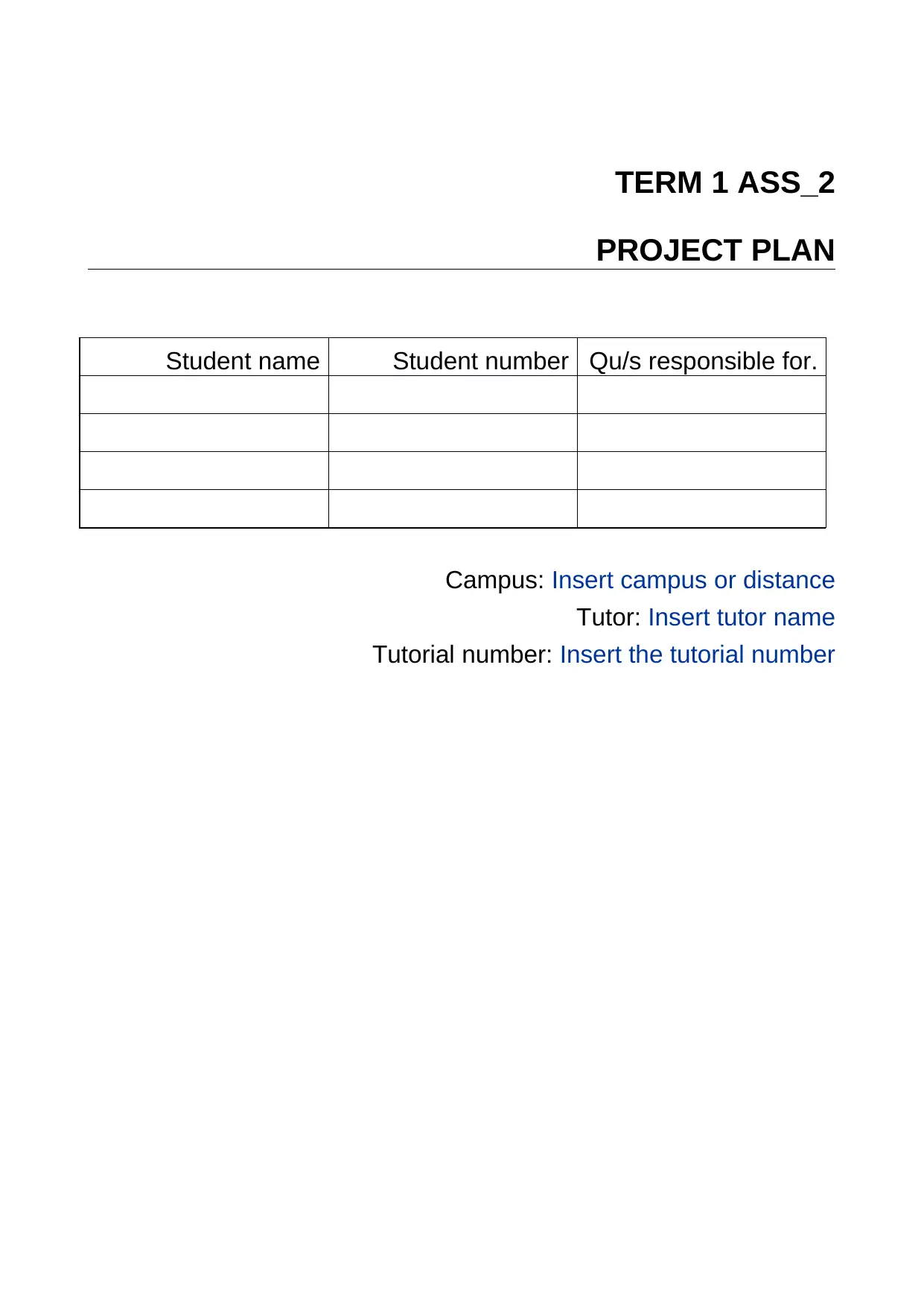
TERM 1 ASS_2
PROJECT PLAN
Campus: Insert campus or distance
Tutor: Insert tutor name
Tutorial number: Insert the tutorial number
Student name Student number Qu/s responsible for.
PROJECT PLAN
Campus: Insert campus or distance
Tutor: Insert tutor name
Tutorial number: Insert the tutorial number
Student name Student number Qu/s responsible for.
Paraphrase This Document
Need a fresh take? Get an instant paraphrase of this document with our AI Paraphraser

Notes to the Author
[This document is a template. It has been tailored to suit the assessment. All fields within the template should
be completed as per the project scenario provided.
Blue italicized text provides an explanation of what should be included for each section. Remove all
blue text prior to submission. If there are two or more options for you to decide between, revert
the option you are keeping to black and remove the other.
[This document is a template. It has been tailored to suit the assessment. All fields within the template should
be completed as per the project scenario provided.
Blue italicized text provides an explanation of what should be included for each section. Remove all
blue text prior to submission. If there are two or more options for you to decide between, revert
the option you are keeping to black and remove the other.
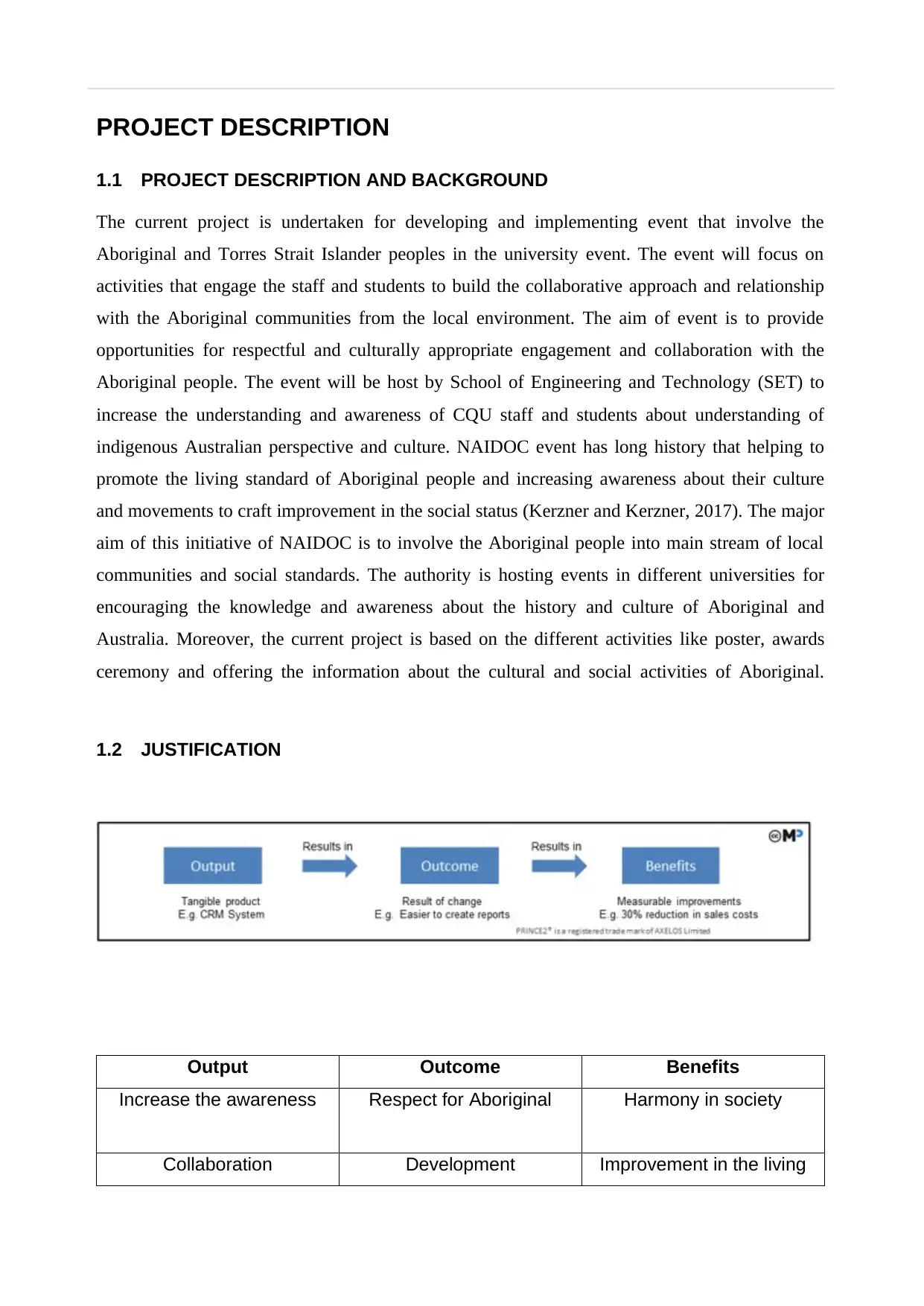
PROJECT DESCRIPTION
1.1 PROJECT DESCRIPTION AND BACKGROUND
The current project is undertaken for developing and implementing event that involve the
Aboriginal and Torres Strait Islander peoples in the university event. The event will focus on
activities that engage the staff and students to build the collaborative approach and relationship
with the Aboriginal communities from the local environment. The aim of event is to provide
opportunities for respectful and culturally appropriate engagement and collaboration with the
Aboriginal people. The event will be host by School of Engineering and Technology (SET) to
increase the understanding and awareness of CQU staff and students about understanding of
indigenous Australian perspective and culture. NAIDOC event has long history that helping to
promote the living standard of Aboriginal people and increasing awareness about their culture
and movements to craft improvement in the social status (Kerzner and Kerzner, 2017). The major
aim of this initiative of NAIDOC is to involve the Aboriginal people into main stream of local
communities and social standards. The authority is hosting events in different universities for
encouraging the knowledge and awareness about the history and culture of Aboriginal and
Australia. Moreover, the current project is based on the different activities like poster, awards
ceremony and offering the information about the cultural and social activities of Aboriginal.
1.2 JUSTIFICATION
Output Outcome Benefits
Increase the awareness Respect for Aboriginal Harmony in society
Collaboration Development Improvement in the living
1.1 PROJECT DESCRIPTION AND BACKGROUND
The current project is undertaken for developing and implementing event that involve the
Aboriginal and Torres Strait Islander peoples in the university event. The event will focus on
activities that engage the staff and students to build the collaborative approach and relationship
with the Aboriginal communities from the local environment. The aim of event is to provide
opportunities for respectful and culturally appropriate engagement and collaboration with the
Aboriginal people. The event will be host by School of Engineering and Technology (SET) to
increase the understanding and awareness of CQU staff and students about understanding of
indigenous Australian perspective and culture. NAIDOC event has long history that helping to
promote the living standard of Aboriginal people and increasing awareness about their culture
and movements to craft improvement in the social status (Kerzner and Kerzner, 2017). The major
aim of this initiative of NAIDOC is to involve the Aboriginal people into main stream of local
communities and social standards. The authority is hosting events in different universities for
encouraging the knowledge and awareness about the history and culture of Aboriginal and
Australia. Moreover, the current project is based on the different activities like poster, awards
ceremony and offering the information about the cultural and social activities of Aboriginal.
1.2 JUSTIFICATION
Output Outcome Benefits
Increase the awareness Respect for Aboriginal Harmony in society
Collaboration Development Improvement in the living
⊘ This is a preview!⊘
Do you want full access?
Subscribe today to unlock all pages.

Trusted by 1+ million students worldwide
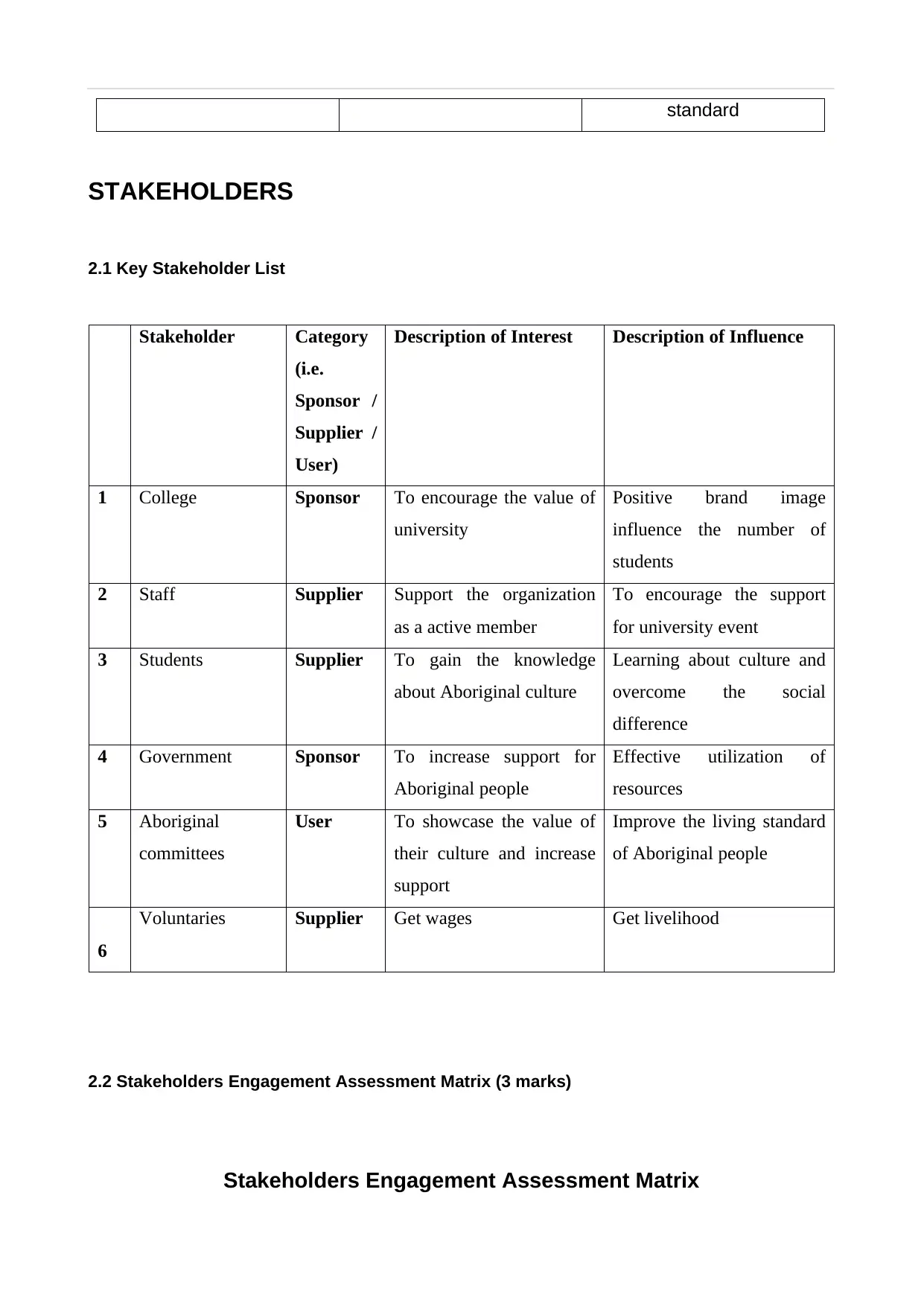
standard
STAKEHOLDERS
2.1 Key Stakeholder List
Stakeholder Category
(i.e.
Sponsor /
Supplier /
User)
Description of Interest Description of Influence
1 College Sponsor To encourage the value of
university
Positive brand image
influence the number of
students
2 Staff Supplier Support the organization
as a active member
To encourage the support
for university event
3 Students Supplier To gain the knowledge
about Aboriginal culture
Learning about culture and
overcome the social
difference
4 Government Sponsor To increase support for
Aboriginal people
Effective utilization of
resources
5 Aboriginal
committees
User To showcase the value of
their culture and increase
support
Improve the living standard
of Aboriginal people
6
Voluntaries Supplier Get wages Get livelihood
2.2 Stakeholders Engagement Assessment Matrix (3 marks)
Stakeholders Engagement Assessment Matrix
STAKEHOLDERS
2.1 Key Stakeholder List
Stakeholder Category
(i.e.
Sponsor /
Supplier /
User)
Description of Interest Description of Influence
1 College Sponsor To encourage the value of
university
Positive brand image
influence the number of
students
2 Staff Supplier Support the organization
as a active member
To encourage the support
for university event
3 Students Supplier To gain the knowledge
about Aboriginal culture
Learning about culture and
overcome the social
difference
4 Government Sponsor To increase support for
Aboriginal people
Effective utilization of
resources
5 Aboriginal
committees
User To showcase the value of
their culture and increase
support
Improve the living standard
of Aboriginal people
6
Voluntaries Supplier Get wages Get livelihood
2.2 Stakeholders Engagement Assessment Matrix (3 marks)
Stakeholders Engagement Assessment Matrix
Paraphrase This Document
Need a fresh take? Get an instant paraphrase of this document with our AI Paraphraser
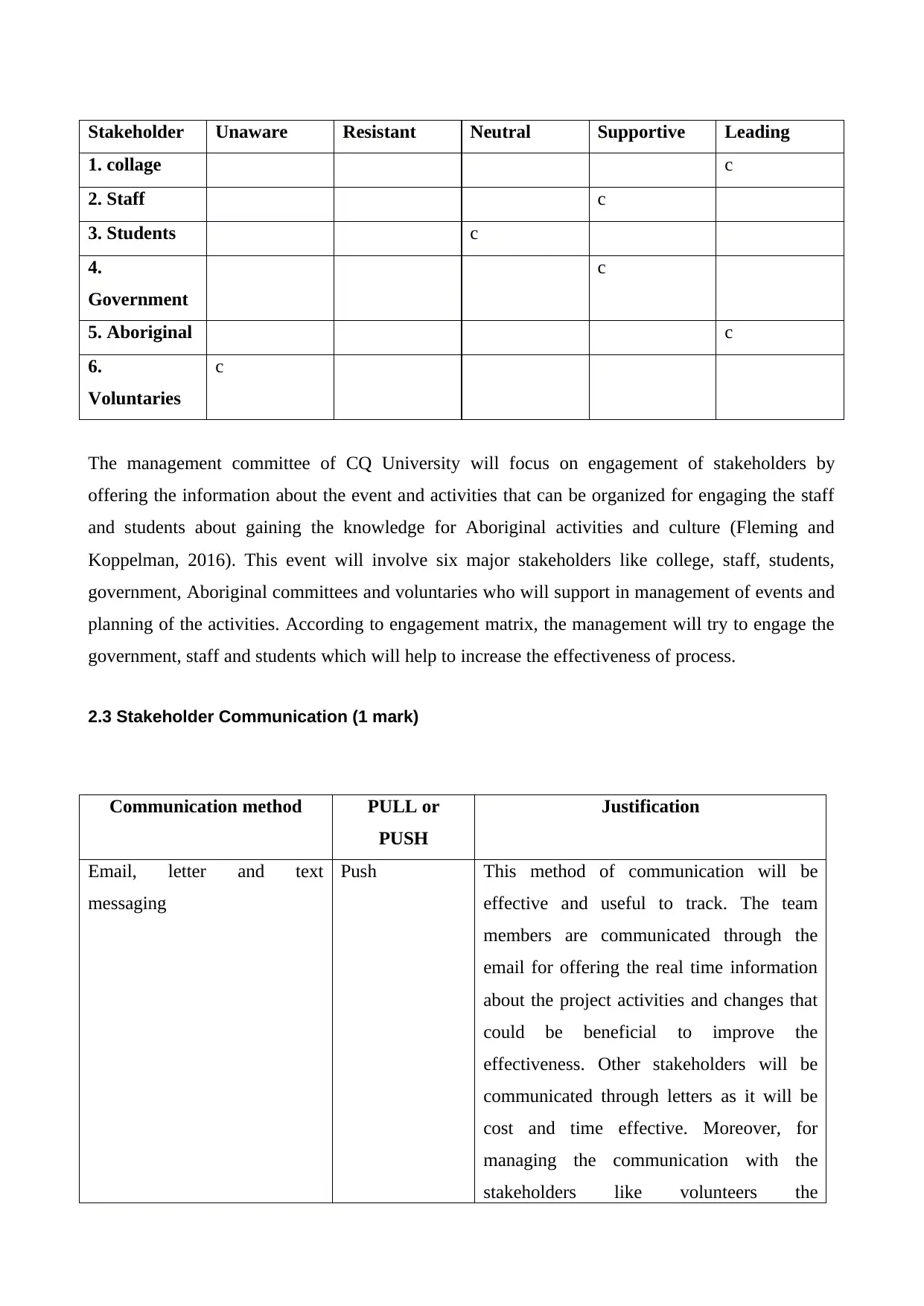
Stakeholder Unaware Resistant Neutral Supportive Leading
1. collage c
2. Staff c
3. Students c
4.
Government
c
5. Aboriginal c
6.
Voluntaries
c
The management committee of CQ University will focus on engagement of stakeholders by
offering the information about the event and activities that can be organized for engaging the staff
and students about gaining the knowledge for Aboriginal activities and culture (Fleming and
Koppelman, 2016). This event will involve six major stakeholders like college, staff, students,
government, Aboriginal committees and voluntaries who will support in management of events and
planning of the activities. According to engagement matrix, the management will try to engage the
government, staff and students which will help to increase the effectiveness of process.
2.3 Stakeholder Communication (1 mark)
Communication method PULL or
PUSH
Justification
Email, letter and text
messaging
Push This method of communication will be
effective and useful to track. The team
members are communicated through the
email for offering the real time information
about the project activities and changes that
could be beneficial to improve the
effectiveness. Other stakeholders will be
communicated through letters as it will be
cost and time effective. Moreover, for
managing the communication with the
stakeholders like volunteers the
1. collage c
2. Staff c
3. Students c
4.
Government
c
5. Aboriginal c
6.
Voluntaries
c
The management committee of CQ University will focus on engagement of stakeholders by
offering the information about the event and activities that can be organized for engaging the staff
and students about gaining the knowledge for Aboriginal activities and culture (Fleming and
Koppelman, 2016). This event will involve six major stakeholders like college, staff, students,
government, Aboriginal committees and voluntaries who will support in management of events and
planning of the activities. According to engagement matrix, the management will try to engage the
government, staff and students which will help to increase the effectiveness of process.
2.3 Stakeholder Communication (1 mark)
Communication method PULL or
PUSH
Justification
Email, letter and text
messaging
Push This method of communication will be
effective and useful to track. The team
members are communicated through the
email for offering the real time information
about the project activities and changes that
could be beneficial to improve the
effectiveness. Other stakeholders will be
communicated through letters as it will be
cost and time effective. Moreover, for
managing the communication with the
stakeholders like volunteers the

management could use the text messaging
method. This method will support to share
real time information with them to schedule
the activities and manage the operation
according to plan.
method. This method will support to share
real time information with them to schedule
the activities and manage the operation
according to plan.
⊘ This is a preview!⊘
Do you want full access?
Subscribe today to unlock all pages.

Trusted by 1+ million students worldwide
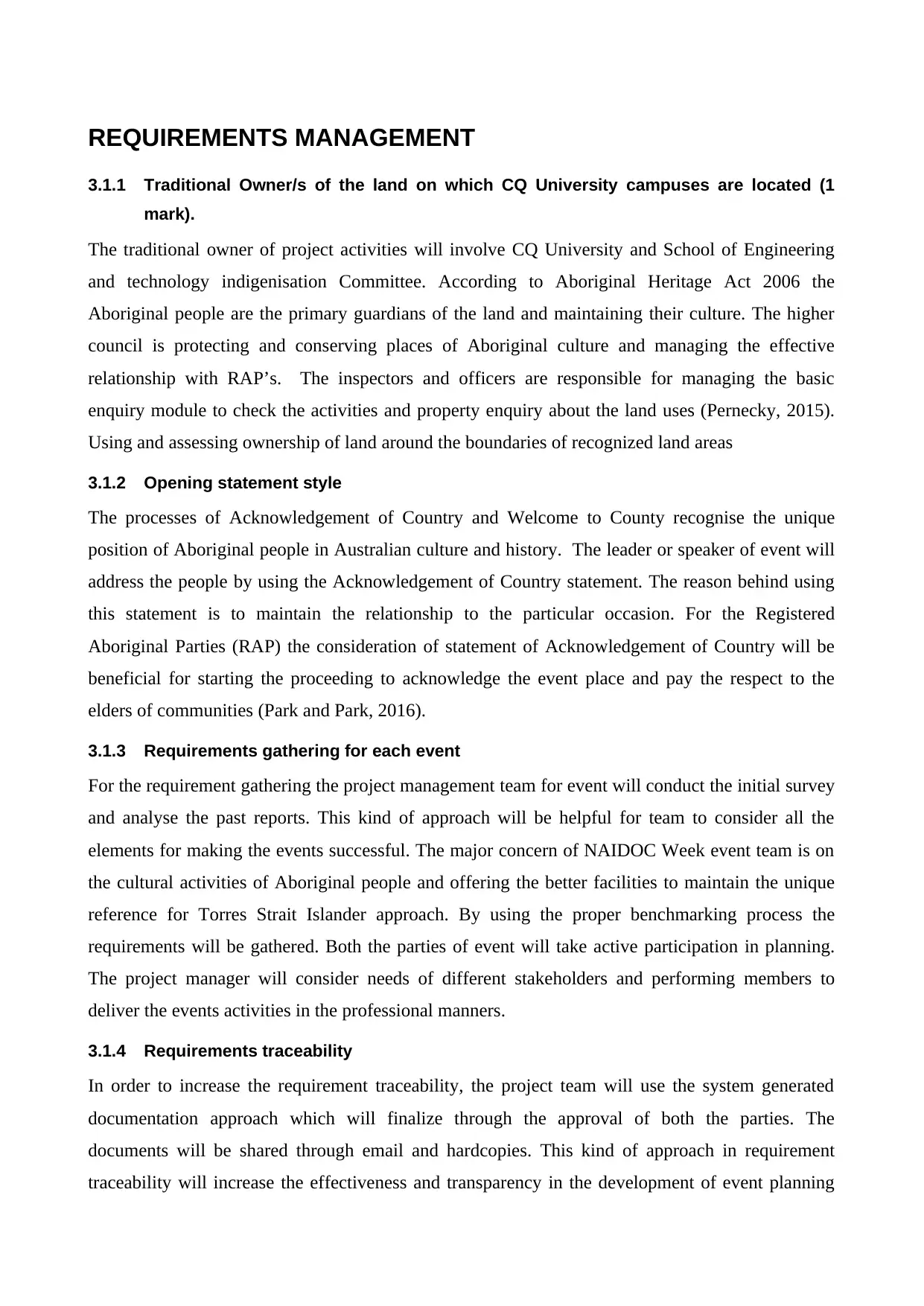
REQUIREMENTS MANAGEMENT
3.1.1 Traditional Owner/s of the land on which CQ University campuses are located (1
mark).
The traditional owner of project activities will involve CQ University and School of Engineering
and technology indigenisation Committee. According to Aboriginal Heritage Act 2006 the
Aboriginal people are the primary guardians of the land and maintaining their culture. The higher
council is protecting and conserving places of Aboriginal culture and managing the effective
relationship with RAP’s. The inspectors and officers are responsible for managing the basic
enquiry module to check the activities and property enquiry about the land uses (Pernecky, 2015).
Using and assessing ownership of land around the boundaries of recognized land areas
3.1.2 Opening statement style
The processes of Acknowledgement of Country and Welcome to County recognise the unique
position of Aboriginal people in Australian culture and history. The leader or speaker of event will
address the people by using the Acknowledgement of Country statement. The reason behind using
this statement is to maintain the relationship to the particular occasion. For the Registered
Aboriginal Parties (RAP) the consideration of statement of Acknowledgement of Country will be
beneficial for starting the proceeding to acknowledge the event place and pay the respect to the
elders of communities (Park and Park, 2016).
3.1.3 Requirements gathering for each event
For the requirement gathering the project management team for event will conduct the initial survey
and analyse the past reports. This kind of approach will be helpful for team to consider all the
elements for making the events successful. The major concern of NAIDOC Week event team is on
the cultural activities of Aboriginal people and offering the better facilities to maintain the unique
reference for Torres Strait Islander approach. By using the proper benchmarking process the
requirements will be gathered. Both the parties of event will take active participation in planning.
The project manager will consider needs of different stakeholders and performing members to
deliver the events activities in the professional manners.
3.1.4 Requirements traceability
In order to increase the requirement traceability, the project team will use the system generated
documentation approach which will finalize through the approval of both the parties. The
documents will be shared through email and hardcopies. This kind of approach in requirement
traceability will increase the effectiveness and transparency in the development of event planning
3.1.1 Traditional Owner/s of the land on which CQ University campuses are located (1
mark).
The traditional owner of project activities will involve CQ University and School of Engineering
and technology indigenisation Committee. According to Aboriginal Heritage Act 2006 the
Aboriginal people are the primary guardians of the land and maintaining their culture. The higher
council is protecting and conserving places of Aboriginal culture and managing the effective
relationship with RAP’s. The inspectors and officers are responsible for managing the basic
enquiry module to check the activities and property enquiry about the land uses (Pernecky, 2015).
Using and assessing ownership of land around the boundaries of recognized land areas
3.1.2 Opening statement style
The processes of Acknowledgement of Country and Welcome to County recognise the unique
position of Aboriginal people in Australian culture and history. The leader or speaker of event will
address the people by using the Acknowledgement of Country statement. The reason behind using
this statement is to maintain the relationship to the particular occasion. For the Registered
Aboriginal Parties (RAP) the consideration of statement of Acknowledgement of Country will be
beneficial for starting the proceeding to acknowledge the event place and pay the respect to the
elders of communities (Park and Park, 2016).
3.1.3 Requirements gathering for each event
For the requirement gathering the project management team for event will conduct the initial survey
and analyse the past reports. This kind of approach will be helpful for team to consider all the
elements for making the events successful. The major concern of NAIDOC Week event team is on
the cultural activities of Aboriginal people and offering the better facilities to maintain the unique
reference for Torres Strait Islander approach. By using the proper benchmarking process the
requirements will be gathered. Both the parties of event will take active participation in planning.
The project manager will consider needs of different stakeholders and performing members to
deliver the events activities in the professional manners.
3.1.4 Requirements traceability
In order to increase the requirement traceability, the project team will use the system generated
documentation approach which will finalize through the approval of both the parties. The
documents will be shared through email and hardcopies. This kind of approach in requirement
traceability will increase the effectiveness and transparency in the development of event planning
Paraphrase This Document
Need a fresh take? Get an instant paraphrase of this document with our AI Paraphraser
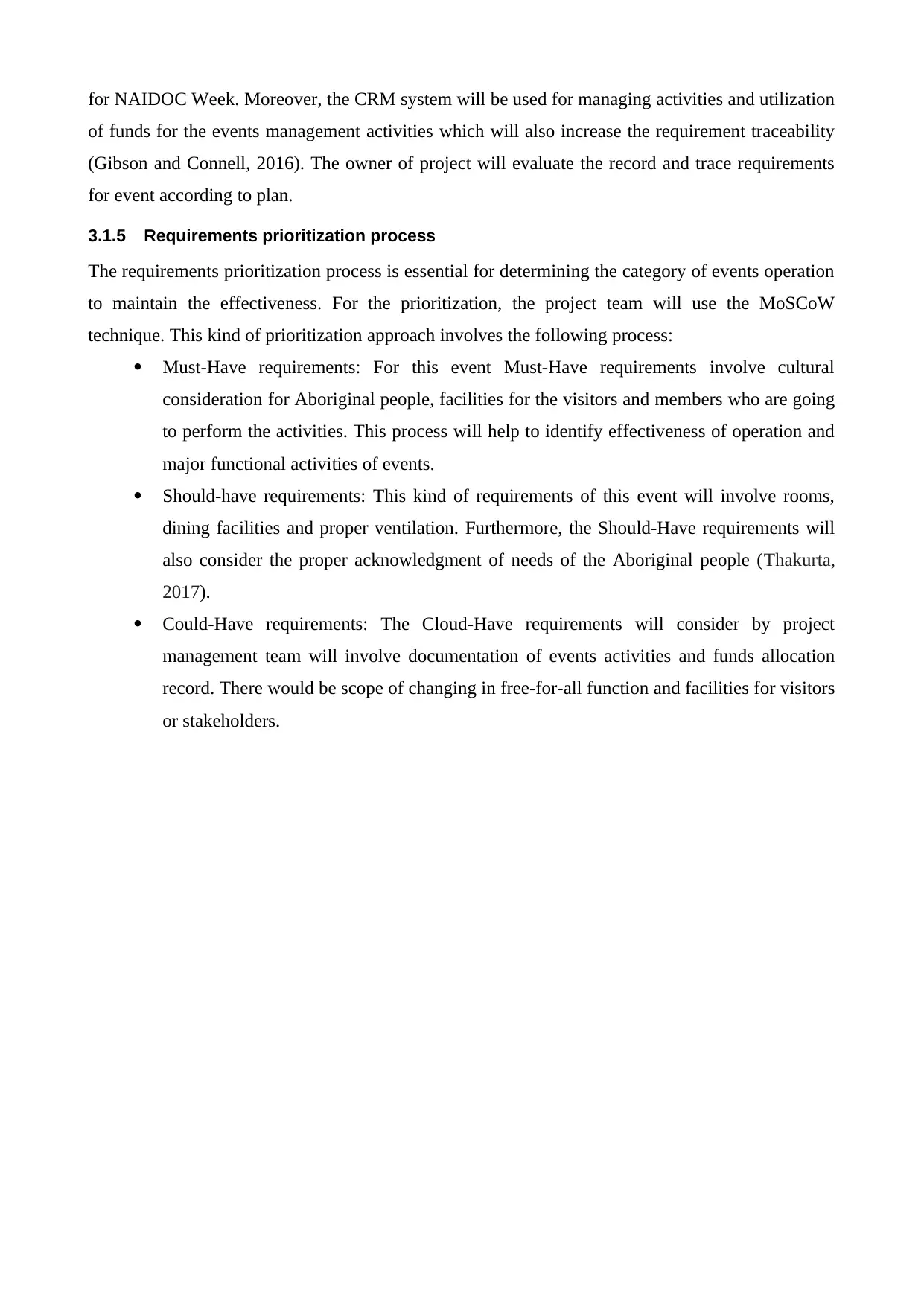
for NAIDOC Week. Moreover, the CRM system will be used for managing activities and utilization
of funds for the events management activities which will also increase the requirement traceability
(Gibson and Connell, 2016). The owner of project will evaluate the record and trace requirements
for event according to plan.
3.1.5 Requirements prioritization process
The requirements prioritization process is essential for determining the category of events operation
to maintain the effectiveness. For the prioritization, the project team will use the MoSCoW
technique. This kind of prioritization approach involves the following process:
Must-Have requirements: For this event Must-Have requirements involve cultural
consideration for Aboriginal people, facilities for the visitors and members who are going
to perform the activities. This process will help to identify effectiveness of operation and
major functional activities of events.
Should-have requirements: This kind of requirements of this event will involve rooms,
dining facilities and proper ventilation. Furthermore, the Should-Have requirements will
also consider the proper acknowledgment of needs of the Aboriginal people (Thakurta,
2017).
Could-Have requirements: The Cloud-Have requirements will consider by project
management team will involve documentation of events activities and funds allocation
record. There would be scope of changing in free-for-all function and facilities for visitors
or stakeholders.
of funds for the events management activities which will also increase the requirement traceability
(Gibson and Connell, 2016). The owner of project will evaluate the record and trace requirements
for event according to plan.
3.1.5 Requirements prioritization process
The requirements prioritization process is essential for determining the category of events operation
to maintain the effectiveness. For the prioritization, the project team will use the MoSCoW
technique. This kind of prioritization approach involves the following process:
Must-Have requirements: For this event Must-Have requirements involve cultural
consideration for Aboriginal people, facilities for the visitors and members who are going
to perform the activities. This process will help to identify effectiveness of operation and
major functional activities of events.
Should-have requirements: This kind of requirements of this event will involve rooms,
dining facilities and proper ventilation. Furthermore, the Should-Have requirements will
also consider the proper acknowledgment of needs of the Aboriginal people (Thakurta,
2017).
Could-Have requirements: The Cloud-Have requirements will consider by project
management team will involve documentation of events activities and funds allocation
record. There would be scope of changing in free-for-all function and facilities for visitors
or stakeholders.
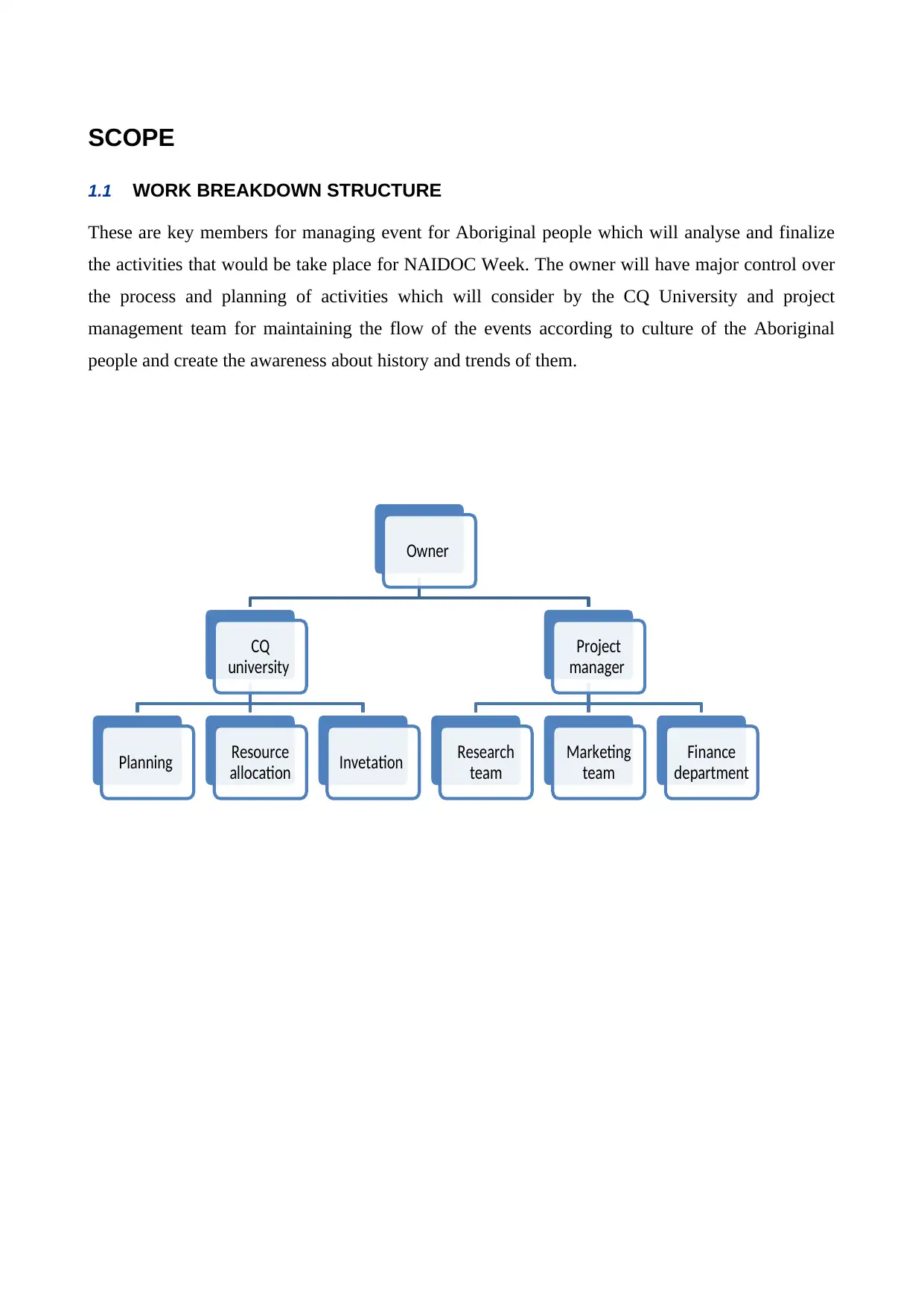
SCOPE
1.1 WORK BREAKDOWN STRUCTURE
These are key members for managing event for Aboriginal people which will analyse and finalize
the activities that would be take place for NAIDOC Week. The owner will have major control over
the process and planning of activities which will consider by the CQ University and project
management team for maintaining the flow of the events according to culture of the Aboriginal
people and create the awareness about history and trends of them.
Owner
CQ
university
Planning Resource
allocation Invetation
Project
manager
Research
team
Marketing
team
Finance
department
1.1 WORK BREAKDOWN STRUCTURE
These are key members for managing event for Aboriginal people which will analyse and finalize
the activities that would be take place for NAIDOC Week. The owner will have major control over
the process and planning of activities which will consider by the CQ University and project
management team for maintaining the flow of the events according to culture of the Aboriginal
people and create the awareness about history and trends of them.
Owner
CQ
university
Planning Resource
allocation Invetation
Project
manager
Research
team
Marketing
team
Finance
department
⊘ This is a preview!⊘
Do you want full access?
Subscribe today to unlock all pages.

Trusted by 1+ million students worldwide
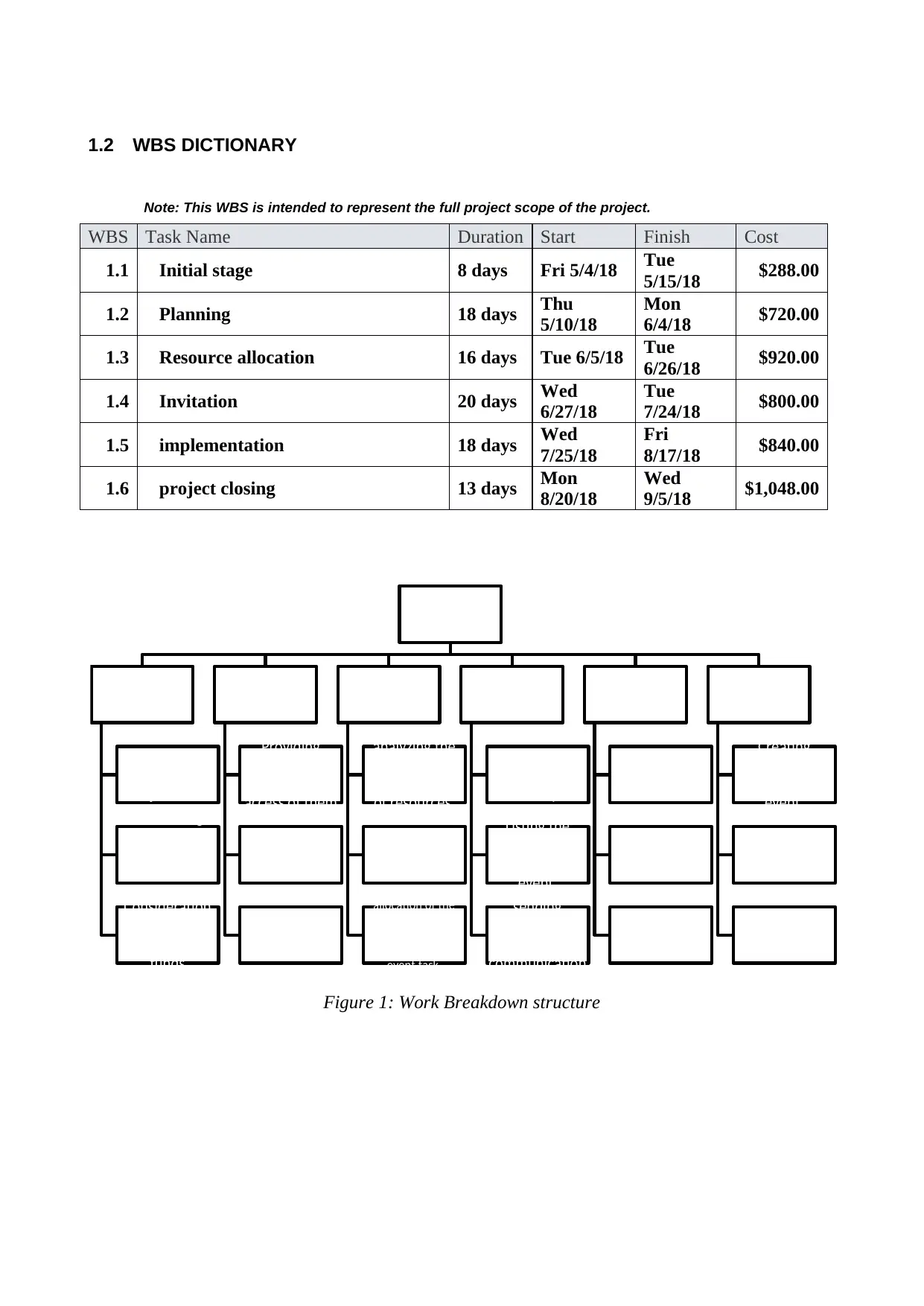
1.2 WBS DICTIONARY
Note: This WBS is intended to represent the full project scope of the project.
WBS Task Name Duration Start Finish Cost
1.1 Initial stage 8 days Fri 5/4/18 Tue
5/15/18 $288.00
1.2 Planning 18 days Thu
5/10/18
Mon
6/4/18 $720.00
1.3 Resource allocation 16 days Tue 6/5/18 Tue
6/26/18 $920.00
1.4 Invitation 20 days Wed
6/27/18
Tue
7/24/18 $800.00
1.5 implementation 18 days Wed
7/25/18
Fri
8/17/18 $840.00
1.6 project closing 13 days Mon
8/20/18
Wed
9/5/18 $1,048.00
Figure 1: Work Breakdown structure
NAIDOC event
Initial stage
formulating
aim and
objectives
Conducting
research on
similar subjects
to analyze the
situation
Consideration
of needs and
offering of
funds
Planning
Providing
details about
sources and
access of them
Human
resource
planning
financial
planning
Resource
allocation
analyzing the
needs and
requirements
of resources
Making
arrangement of
the resources
allocation of the
resources as per
the needs and
requirements of
event task
Invitation
Collecting
requirements
and analysis
Listing the
visitors and
members for
event
sending
invitation and
making
communication
implementatio
n
Determination
of cost and
allocation
implementatio
n of even plan
and monitoring
Change and risk
management
project closing
Creating
awareness
about the
event
report writing
project closure
Note: This WBS is intended to represent the full project scope of the project.
WBS Task Name Duration Start Finish Cost
1.1 Initial stage 8 days Fri 5/4/18 Tue
5/15/18 $288.00
1.2 Planning 18 days Thu
5/10/18
Mon
6/4/18 $720.00
1.3 Resource allocation 16 days Tue 6/5/18 Tue
6/26/18 $920.00
1.4 Invitation 20 days Wed
6/27/18
Tue
7/24/18 $800.00
1.5 implementation 18 days Wed
7/25/18
Fri
8/17/18 $840.00
1.6 project closing 13 days Mon
8/20/18
Wed
9/5/18 $1,048.00
Figure 1: Work Breakdown structure
NAIDOC event
Initial stage
formulating
aim and
objectives
Conducting
research on
similar subjects
to analyze the
situation
Consideration
of needs and
offering of
funds
Planning
Providing
details about
sources and
access of them
Human
resource
planning
financial
planning
Resource
allocation
analyzing the
needs and
requirements
of resources
Making
arrangement of
the resources
allocation of the
resources as per
the needs and
requirements of
event task
Invitation
Collecting
requirements
and analysis
Listing the
visitors and
members for
event
sending
invitation and
making
communication
implementatio
n
Determination
of cost and
allocation
implementatio
n of even plan
and monitoring
Change and risk
management
project closing
Creating
awareness
about the
event
report writing
project closure
Paraphrase This Document
Need a fresh take? Get an instant paraphrase of this document with our AI Paraphraser
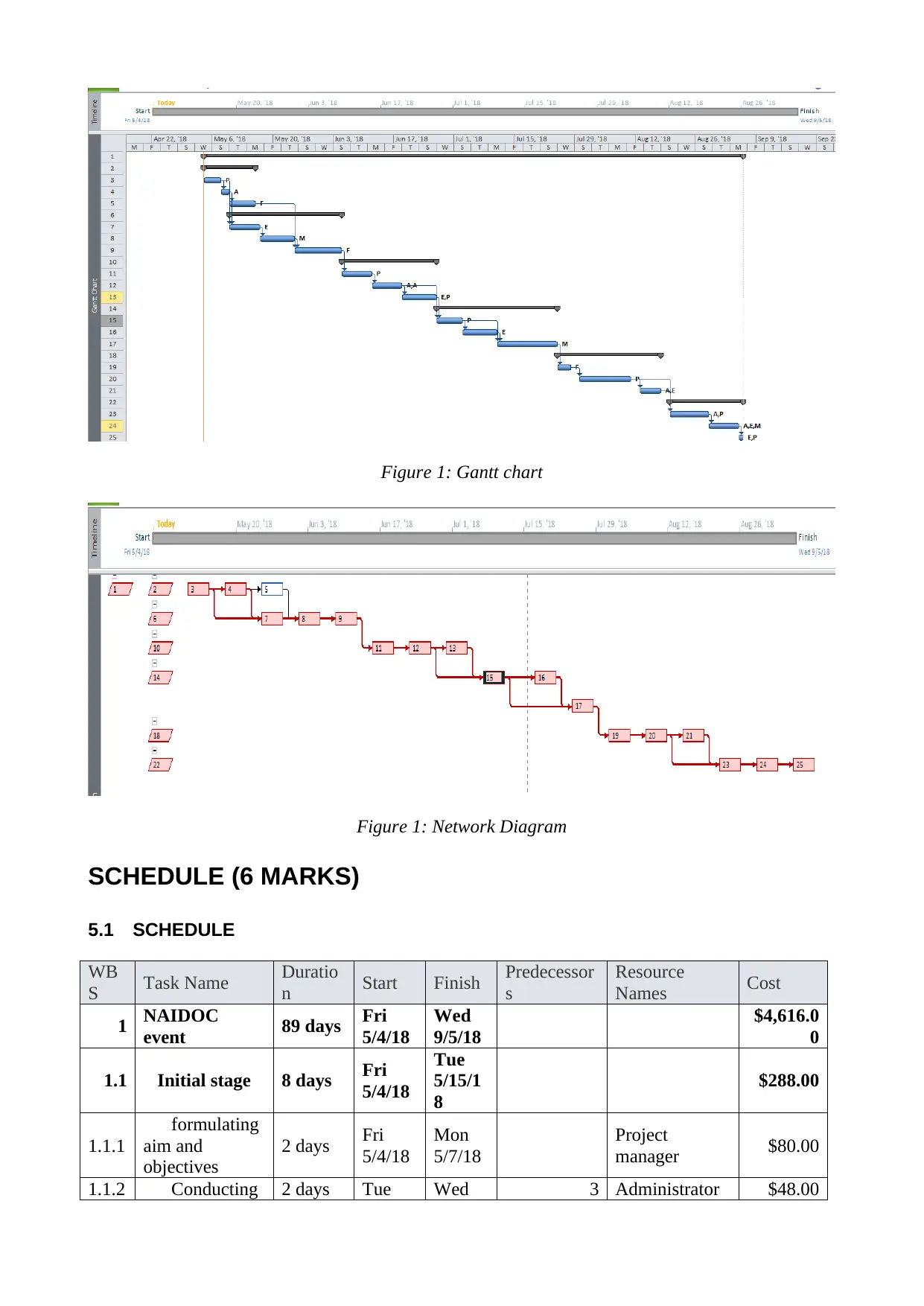
Figure 1: Gantt chart
Figure 1: Network Diagram
SCHEDULE (6 MARKS)
5.1 SCHEDULE
WB
S Task Name Duratio
n Start Finish Predecessor
s
Resource
Names Cost
1 NAIDOC
event 89 days Fri
5/4/18
Wed
9/5/18
$4,616.0
0
1.1 Initial stage 8 days Fri
5/4/18
Tue
5/15/1
8
$288.00
1.1.1
formulating
aim and
objectives
2 days Fri
5/4/18
Mon
5/7/18
Project
manager $80.00
1.1.2 Conducting 2 days Tue Wed 3 Administrator $48.00
Figure 1: Network Diagram
SCHEDULE (6 MARKS)
5.1 SCHEDULE
WB
S Task Name Duratio
n Start Finish Predecessor
s
Resource
Names Cost
1 NAIDOC
event 89 days Fri
5/4/18
Wed
9/5/18
$4,616.0
0
1.1 Initial stage 8 days Fri
5/4/18
Tue
5/15/1
8
$288.00
1.1.1
formulating
aim and
objectives
2 days Fri
5/4/18
Mon
5/7/18
Project
manager $80.00
1.1.2 Conducting 2 days Tue Wed 3 Administrator $48.00
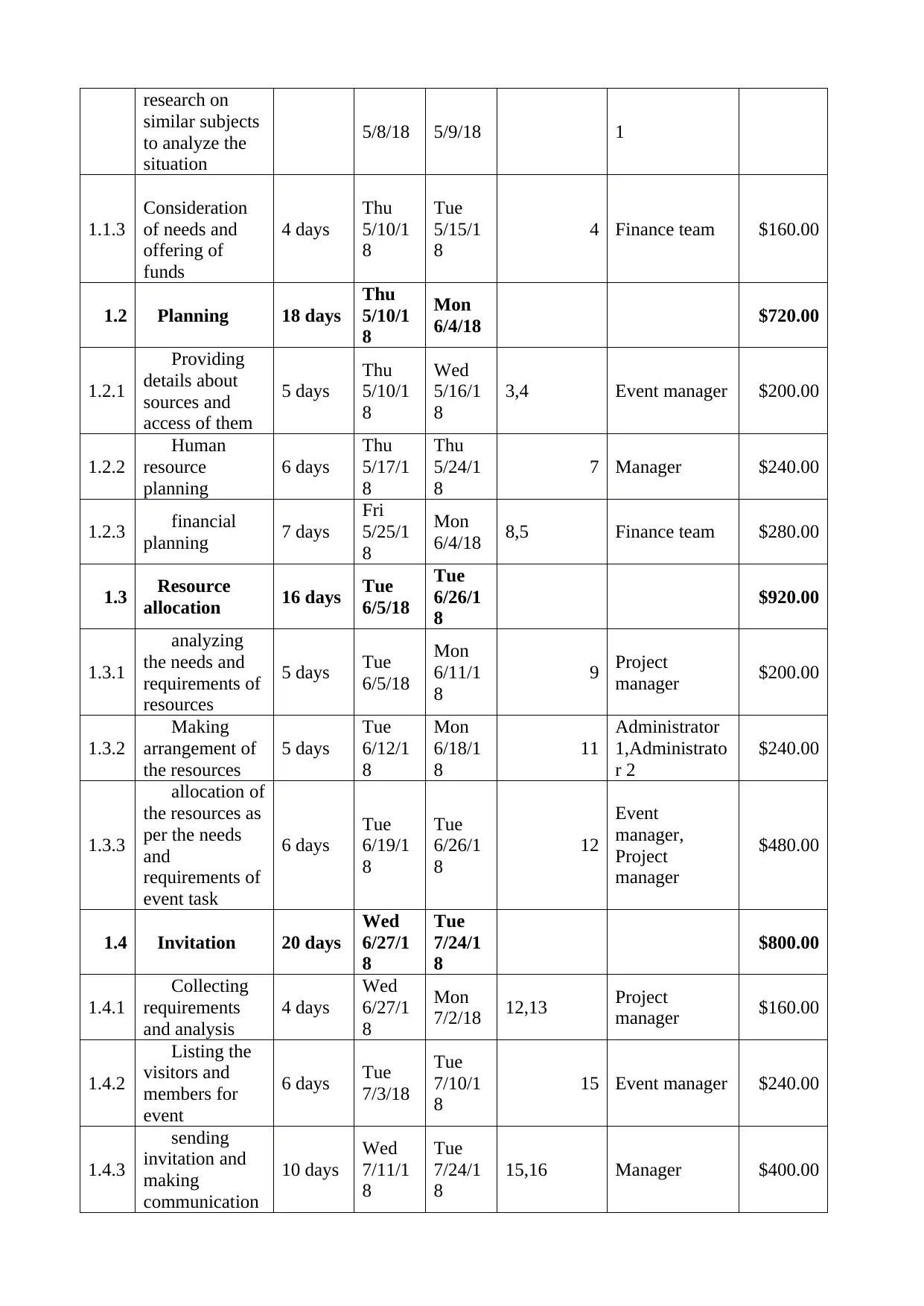
research on
similar subjects
to analyze the
situation
5/8/18 5/9/18 1
1.1.3
Consideration
of needs and
offering of
funds
4 days
Thu
5/10/1
8
Tue
5/15/1
8
4 Finance team $160.00
1.2 Planning 18 days
Thu
5/10/1
8
Mon
6/4/18 $720.00
1.2.1
Providing
details about
sources and
access of them
5 days
Thu
5/10/1
8
Wed
5/16/1
8
3,4 Event manager $200.00
1.2.2
Human
resource
planning
6 days
Thu
5/17/1
8
Thu
5/24/1
8
7 Manager $240.00
1.2.3 financial
planning 7 days
Fri
5/25/1
8
Mon
6/4/18 8,5 Finance team $280.00
1.3 Resource
allocation 16 days Tue
6/5/18
Tue
6/26/1
8
$920.00
1.3.1
analyzing
the needs and
requirements of
resources
5 days Tue
6/5/18
Mon
6/11/1
8
9 Project
manager $200.00
1.3.2
Making
arrangement of
the resources
5 days
Tue
6/12/1
8
Mon
6/18/1
8
11
Administrator
1,Administrato
r 2
$240.00
1.3.3
allocation of
the resources as
per the needs
and
requirements of
event task
6 days
Tue
6/19/1
8
Tue
6/26/1
8
12
Event
manager,
Project
manager
$480.00
1.4 Invitation 20 days
Wed
6/27/1
8
Tue
7/24/1
8
$800.00
1.4.1
Collecting
requirements
and analysis
4 days
Wed
6/27/1
8
Mon
7/2/18 12,13 Project
manager $160.00
1.4.2
Listing the
visitors and
members for
event
6 days Tue
7/3/18
Tue
7/10/1
8
15 Event manager $240.00
1.4.3
sending
invitation and
making
communication
10 days
Wed
7/11/1
8
Tue
7/24/1
8
15,16 Manager $400.00
similar subjects
to analyze the
situation
5/8/18 5/9/18 1
1.1.3
Consideration
of needs and
offering of
funds
4 days
Thu
5/10/1
8
Tue
5/15/1
8
4 Finance team $160.00
1.2 Planning 18 days
Thu
5/10/1
8
Mon
6/4/18 $720.00
1.2.1
Providing
details about
sources and
access of them
5 days
Thu
5/10/1
8
Wed
5/16/1
8
3,4 Event manager $200.00
1.2.2
Human
resource
planning
6 days
Thu
5/17/1
8
Thu
5/24/1
8
7 Manager $240.00
1.2.3 financial
planning 7 days
Fri
5/25/1
8
Mon
6/4/18 8,5 Finance team $280.00
1.3 Resource
allocation 16 days Tue
6/5/18
Tue
6/26/1
8
$920.00
1.3.1
analyzing
the needs and
requirements of
resources
5 days Tue
6/5/18
Mon
6/11/1
8
9 Project
manager $200.00
1.3.2
Making
arrangement of
the resources
5 days
Tue
6/12/1
8
Mon
6/18/1
8
11
Administrator
1,Administrato
r 2
$240.00
1.3.3
allocation of
the resources as
per the needs
and
requirements of
event task
6 days
Tue
6/19/1
8
Tue
6/26/1
8
12
Event
manager,
Project
manager
$480.00
1.4 Invitation 20 days
Wed
6/27/1
8
Tue
7/24/1
8
$800.00
1.4.1
Collecting
requirements
and analysis
4 days
Wed
6/27/1
8
Mon
7/2/18 12,13 Project
manager $160.00
1.4.2
Listing the
visitors and
members for
event
6 days Tue
7/3/18
Tue
7/10/1
8
15 Event manager $240.00
1.4.3
sending
invitation and
making
communication
10 days
Wed
7/11/1
8
Tue
7/24/1
8
15,16 Manager $400.00
⊘ This is a preview!⊘
Do you want full access?
Subscribe today to unlock all pages.

Trusted by 1+ million students worldwide
1 out of 15
Related Documents
Your All-in-One AI-Powered Toolkit for Academic Success.
+13062052269
info@desklib.com
Available 24*7 on WhatsApp / Email
![[object Object]](/_next/static/media/star-bottom.7253800d.svg)
Unlock your academic potential
Copyright © 2020–2025 A2Z Services. All Rights Reserved. Developed and managed by ZUCOL.





